Climate Change in Australia: Factors, Impacts, and Solutions
VerifiedAdded on 2020/07/22
|7
|1220
|77
Report
AI Summary
This report provides a comprehensive overview of climate change in Australia, examining the significant changes in weather patterns over the past century. It discusses the factors contributing to climate change, including global warming, deforestation, and increased carbon emissions, and their impact on Australia. The report highlights the consequences of these changes, such as increased temperatures, droughts, and natural disasters like floods and bushfires. It also explores the effects on flora and fauna, the rising sea levels, and the implications for infrastructure and public health. The report references various sources, including books, journals, and online resources, to support its findings and emphasize the urgent need to address climate change and its effects on the Australian environment and population. It also touches upon the impacts of changing weather patterns on agriculture and the need for revised water management strategies, emphasizing the need to adapt to the changing climate. The report concludes by summarizing the major impacts and the importance of addressing climate change to mitigate its effects.
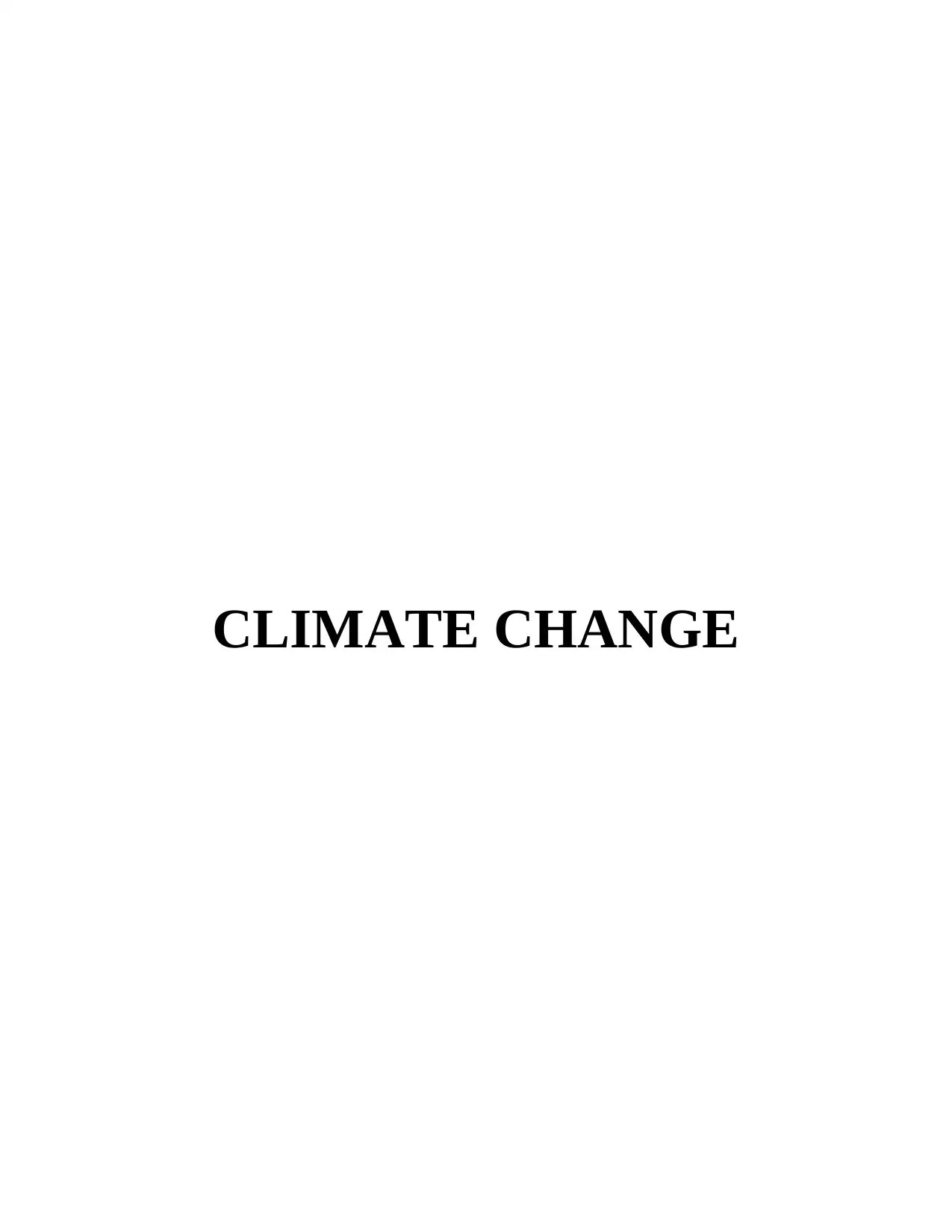
CLIMATE CHANGE
Paraphrase This Document
Need a fresh take? Get an instant paraphrase of this document with our AI Paraphraser
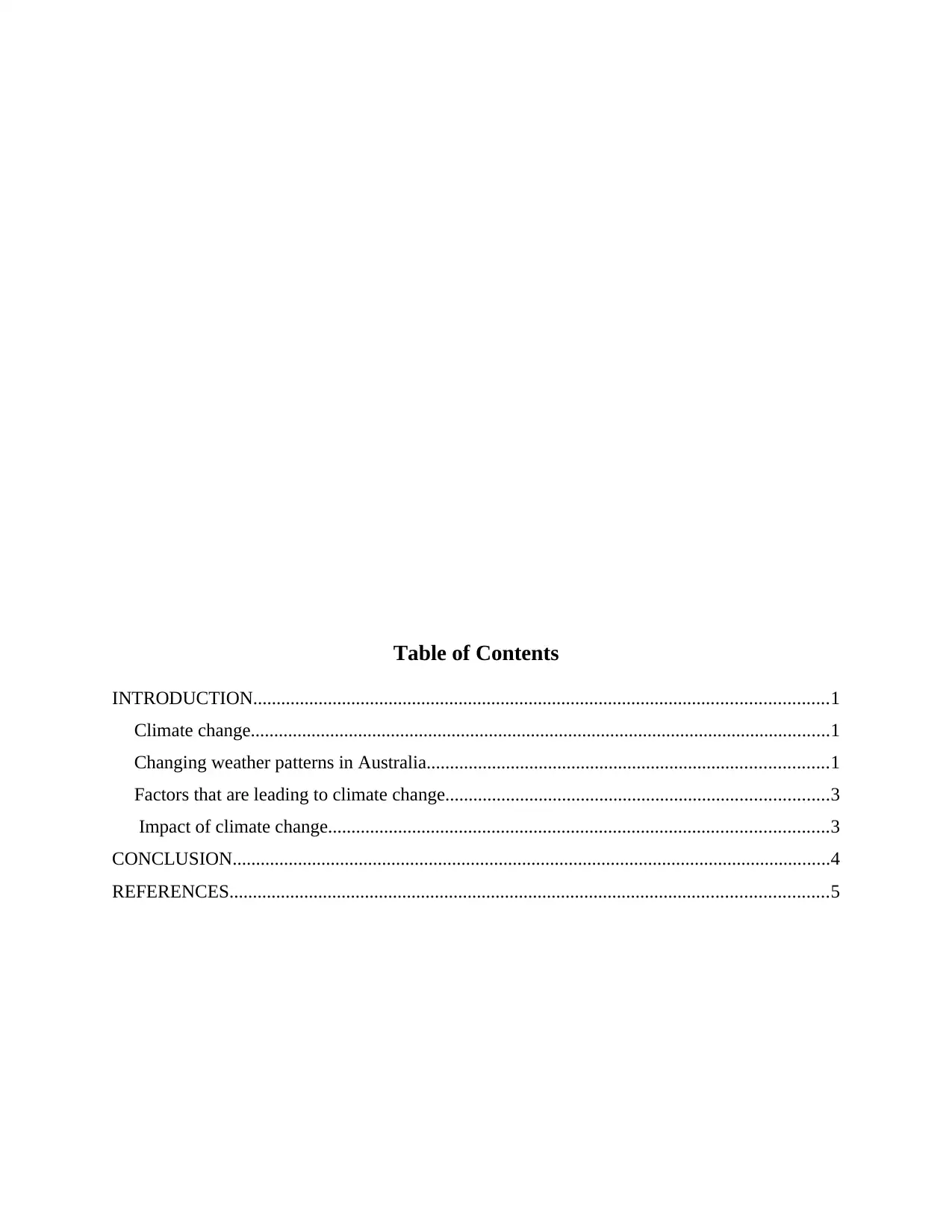
Table of Contents
INTRODUCTION...........................................................................................................................1
Climate change............................................................................................................................1
Changing weather patterns in Australia......................................................................................1
Factors that are leading to climate change..................................................................................3
Impact of climate change...........................................................................................................3
CONCLUSION................................................................................................................................4
REFERENCES................................................................................................................................5
INTRODUCTION...........................................................................................................................1
Climate change............................................................................................................................1
Changing weather patterns in Australia......................................................................................1
Factors that are leading to climate change..................................................................................3
Impact of climate change...........................................................................................................3
CONCLUSION................................................................................................................................4
REFERENCES................................................................................................................................5
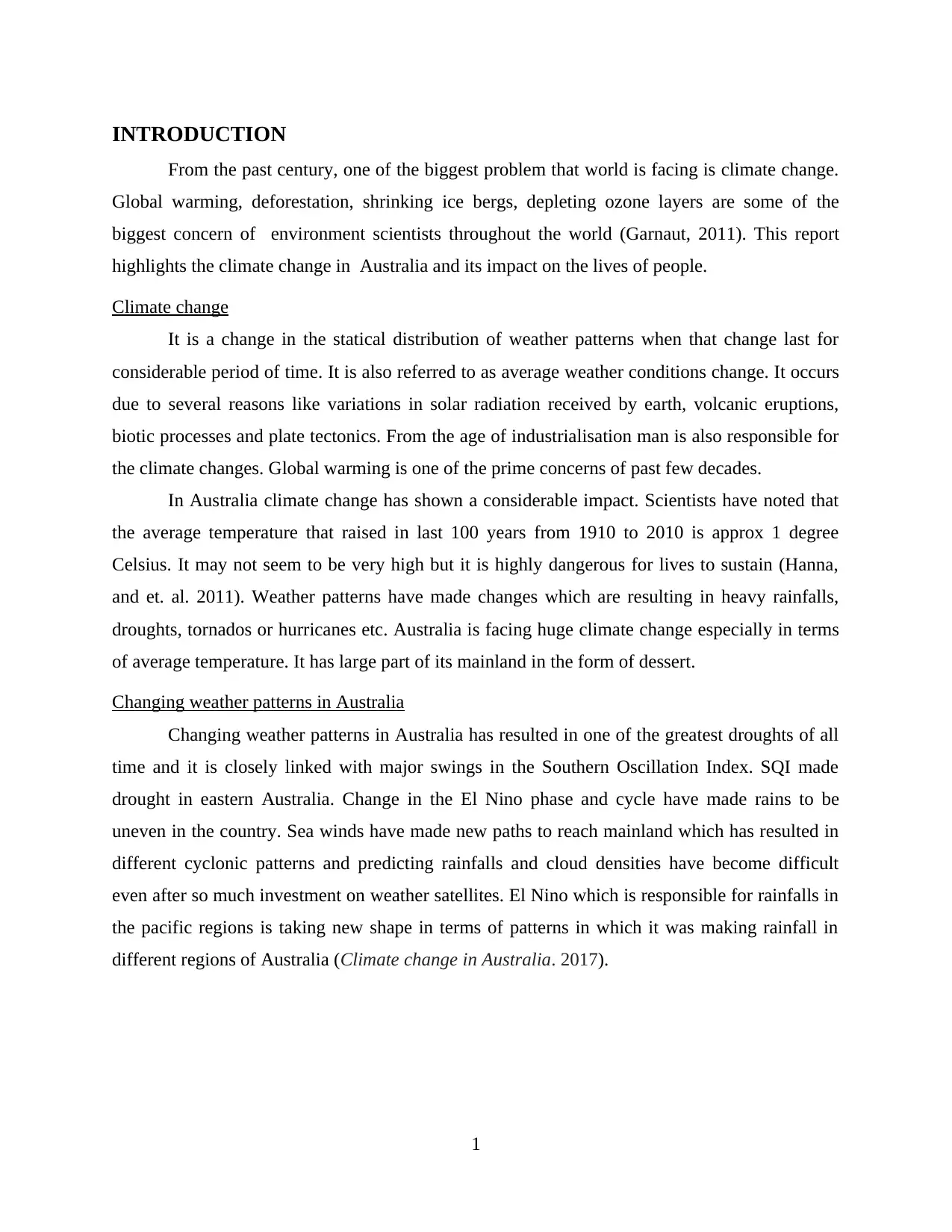
INTRODUCTION
From the past century, one of the biggest problem that world is facing is climate change.
Global warming, deforestation, shrinking ice bergs, depleting ozone layers are some of the
biggest concern of environment scientists throughout the world (Garnaut, 2011). This report
highlights the climate change in Australia and its impact on the lives of people.
Climate change
It is a change in the statical distribution of weather patterns when that change last for
considerable period of time. It is also referred to as average weather conditions change. It occurs
due to several reasons like variations in solar radiation received by earth, volcanic eruptions,
biotic processes and plate tectonics. From the age of industrialisation man is also responsible for
the climate changes. Global warming is one of the prime concerns of past few decades.
In Australia climate change has shown a considerable impact. Scientists have noted that
the average temperature that raised in last 100 years from 1910 to 2010 is approx 1 degree
Celsius. It may not seem to be very high but it is highly dangerous for lives to sustain (Hanna,
and et. al. 2011). Weather patterns have made changes which are resulting in heavy rainfalls,
droughts, tornados or hurricanes etc. Australia is facing huge climate change especially in terms
of average temperature. It has large part of its mainland in the form of dessert.
Changing weather patterns in Australia
Changing weather patterns in Australia has resulted in one of the greatest droughts of all
time and it is closely linked with major swings in the Southern Oscillation Index. SQI made
drought in eastern Australia. Change in the El Nino phase and cycle have made rains to be
uneven in the country. Sea winds have made new paths to reach mainland which has resulted in
different cyclonic patterns and predicting rainfalls and cloud densities have become difficult
even after so much investment on weather satellites. El Nino which is responsible for rainfalls in
the pacific regions is taking new shape in terms of patterns in which it was making rainfall in
different regions of Australia (Climate change in Australia. 2017).
1
From the past century, one of the biggest problem that world is facing is climate change.
Global warming, deforestation, shrinking ice bergs, depleting ozone layers are some of the
biggest concern of environment scientists throughout the world (Garnaut, 2011). This report
highlights the climate change in Australia and its impact on the lives of people.
Climate change
It is a change in the statical distribution of weather patterns when that change last for
considerable period of time. It is also referred to as average weather conditions change. It occurs
due to several reasons like variations in solar radiation received by earth, volcanic eruptions,
biotic processes and plate tectonics. From the age of industrialisation man is also responsible for
the climate changes. Global warming is one of the prime concerns of past few decades.
In Australia climate change has shown a considerable impact. Scientists have noted that
the average temperature that raised in last 100 years from 1910 to 2010 is approx 1 degree
Celsius. It may not seem to be very high but it is highly dangerous for lives to sustain (Hanna,
and et. al. 2011). Weather patterns have made changes which are resulting in heavy rainfalls,
droughts, tornados or hurricanes etc. Australia is facing huge climate change especially in terms
of average temperature. It has large part of its mainland in the form of dessert.
Changing weather patterns in Australia
Changing weather patterns in Australia has resulted in one of the greatest droughts of all
time and it is closely linked with major swings in the Southern Oscillation Index. SQI made
drought in eastern Australia. Change in the El Nino phase and cycle have made rains to be
uneven in the country. Sea winds have made new paths to reach mainland which has resulted in
different cyclonic patterns and predicting rainfalls and cloud densities have become difficult
even after so much investment on weather satellites. El Nino which is responsible for rainfalls in
the pacific regions is taking new shape in terms of patterns in which it was making rainfall in
different regions of Australia (Climate change in Australia. 2017).
1
⊘ This is a preview!⊘
Do you want full access?
Subscribe today to unlock all pages.

Trusted by 1+ million students worldwide
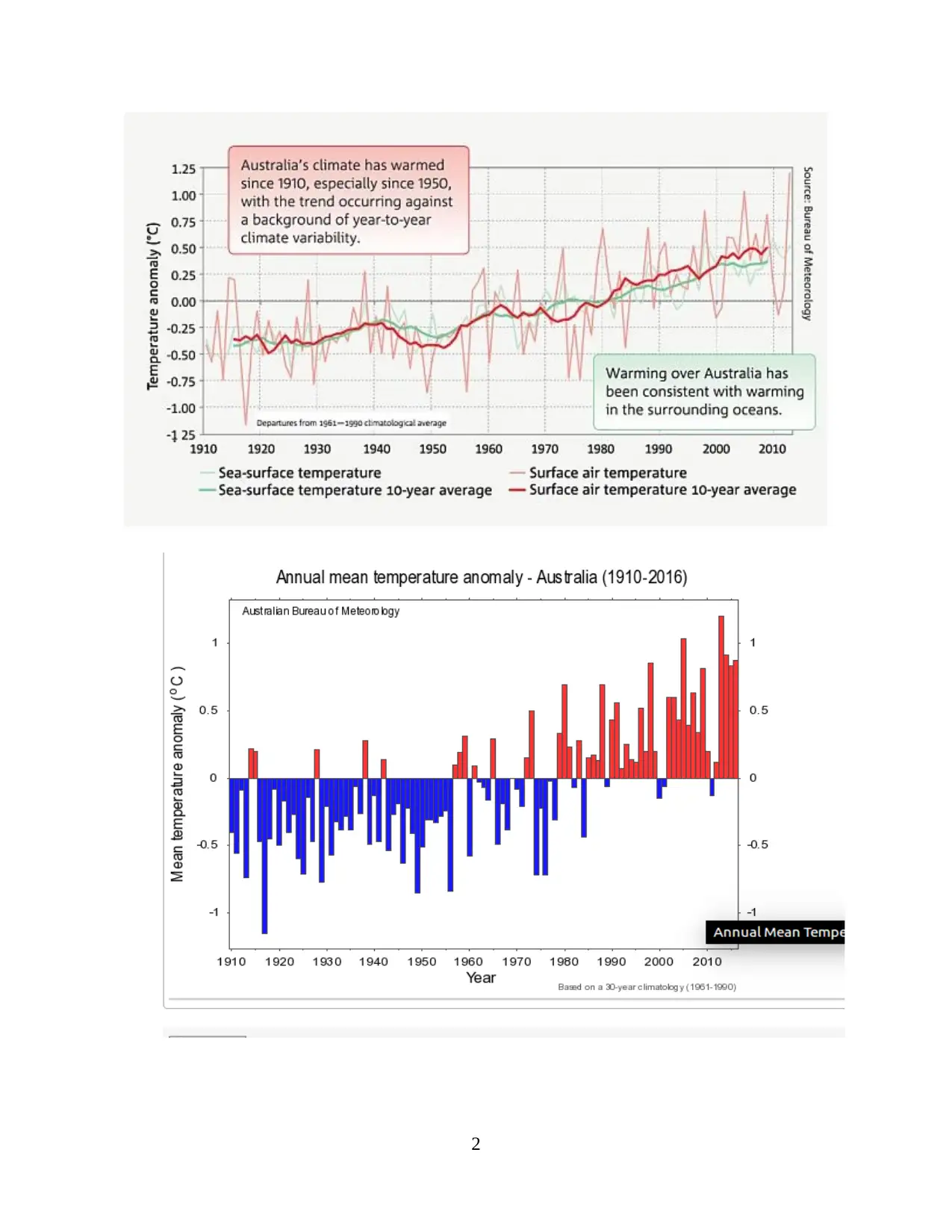
2
Paraphrase This Document
Need a fresh take? Get an instant paraphrase of this document with our AI Paraphraser

Theses Picture shows that there is considerable amount of mean change in temperature of
Australia in past 100 years. This anomaly in extremely hot months was recently seen in the year
2012-2013 which has broken all records (Head and et. al. 2014).
Factors that are leading to climate change
Depletion of Ozone layer and green house effect.
Increased carbon emission and unbalanced carbon cycle.
Reduction in the forest area.
Impact of climate change
One of the severe impacts of climate change is on the flora and fauna. Many of the
species are getting extinct due to climate changes. Australia is a land of many species
which are only found out on this continent and are coming in the endangered species.
Anomaly in temperatures changes can be seen in the weather such as extreme hot months
in summers and extreme snowy winter months.
Skin cancers and sun burns due to depleting ozone layers is highest in Australia in the
whole world.
Natural disasters such as floods, cyclones, drought are common these days. This is due to
change in waterfall levels in various parts of the company. By 2090 winter rainfalls are
expected to be decreased in the eastern Australia. Declining water reservoirs in the south
western Australia is linked with change in atmospheric circulation of weather.
Changing wind patterns have resulted in uprooted trees and has resulted in forest or bush
fires in summers which cost million of money to stop them from reaching to the areas
where there is presence of people (Nyberg, Spicer & Wright, 2013).
Production of crops are getting effected due to uneven weather change. Usual patterns of
farming and its seasons are needed to be changed.
Rising sea levels due to shrinking ice bergs is matter of concern for the countries like
Australia who is on the southern hemisphere and is closer to Antarctica and is surrounded
by oceans from all sides.
Infrastructural needs are changing due to extreme climates as the coastal regions have to
be prepared for heavy rainfall any time so houses and public infrastructure needs to build
in the same ways.
3
Australia in past 100 years. This anomaly in extremely hot months was recently seen in the year
2012-2013 which has broken all records (Head and et. al. 2014).
Factors that are leading to climate change
Depletion of Ozone layer and green house effect.
Increased carbon emission and unbalanced carbon cycle.
Reduction in the forest area.
Impact of climate change
One of the severe impacts of climate change is on the flora and fauna. Many of the
species are getting extinct due to climate changes. Australia is a land of many species
which are only found out on this continent and are coming in the endangered species.
Anomaly in temperatures changes can be seen in the weather such as extreme hot months
in summers and extreme snowy winter months.
Skin cancers and sun burns due to depleting ozone layers is highest in Australia in the
whole world.
Natural disasters such as floods, cyclones, drought are common these days. This is due to
change in waterfall levels in various parts of the company. By 2090 winter rainfalls are
expected to be decreased in the eastern Australia. Declining water reservoirs in the south
western Australia is linked with change in atmospheric circulation of weather.
Changing wind patterns have resulted in uprooted trees and has resulted in forest or bush
fires in summers which cost million of money to stop them from reaching to the areas
where there is presence of people (Nyberg, Spicer & Wright, 2013).
Production of crops are getting effected due to uneven weather change. Usual patterns of
farming and its seasons are needed to be changed.
Rising sea levels due to shrinking ice bergs is matter of concern for the countries like
Australia who is on the southern hemisphere and is closer to Antarctica and is surrounded
by oceans from all sides.
Infrastructural needs are changing due to extreme climates as the coastal regions have to
be prepared for heavy rainfall any time so houses and public infrastructure needs to build
in the same ways.
3
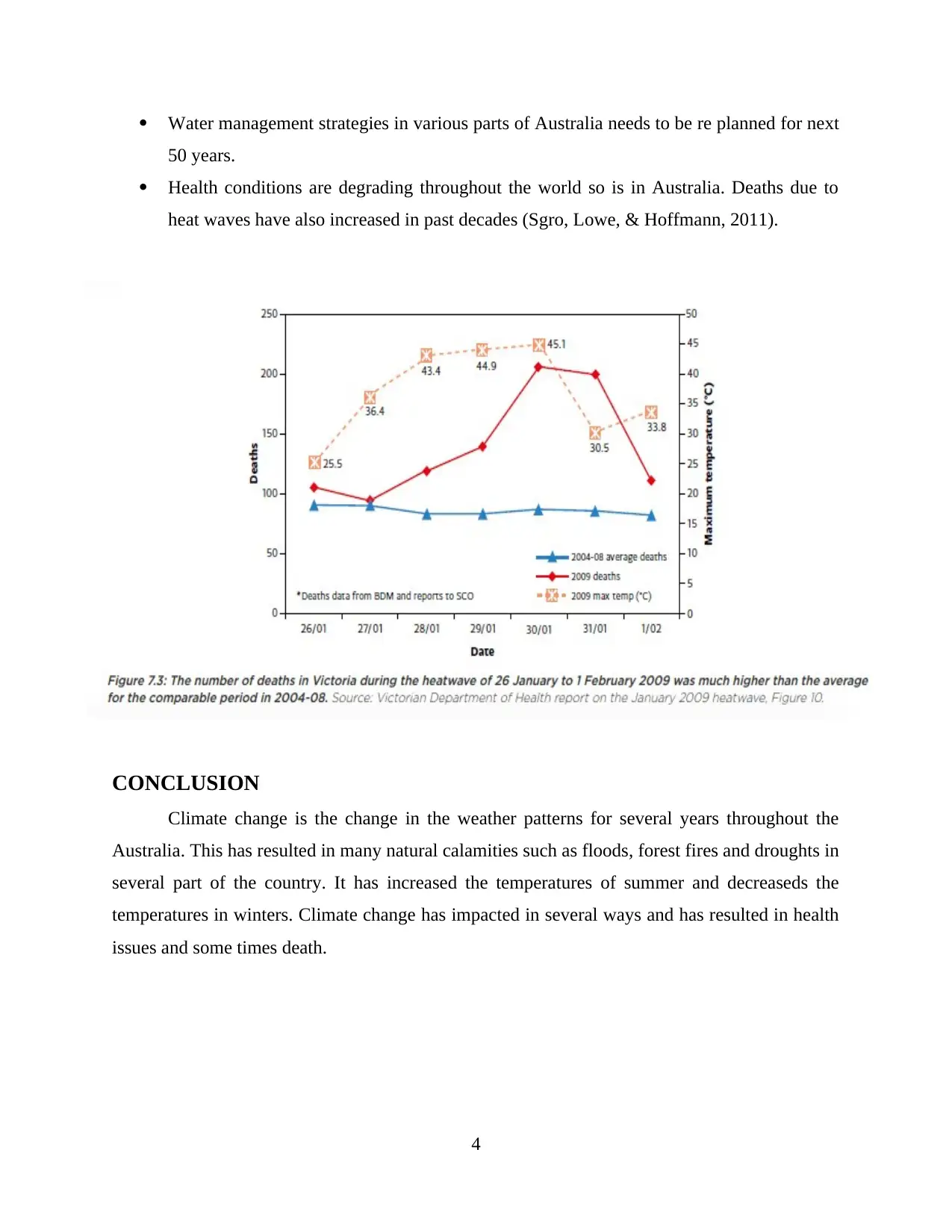
Water management strategies in various parts of Australia needs to be re planned for next
50 years.
Health conditions are degrading throughout the world so is in Australia. Deaths due to
heat waves have also increased in past decades (Sgro, Lowe, & Hoffmann, 2011).
CONCLUSION
Climate change is the change in the weather patterns for several years throughout the
Australia. This has resulted in many natural calamities such as floods, forest fires and droughts in
several part of the country. It has increased the temperatures of summer and decreaseds the
temperatures in winters. Climate change has impacted in several ways and has resulted in health
issues and some times death.
4
50 years.
Health conditions are degrading throughout the world so is in Australia. Deaths due to
heat waves have also increased in past decades (Sgro, Lowe, & Hoffmann, 2011).
CONCLUSION
Climate change is the change in the weather patterns for several years throughout the
Australia. This has resulted in many natural calamities such as floods, forest fires and droughts in
several part of the country. It has increased the temperatures of summer and decreaseds the
temperatures in winters. Climate change has impacted in several ways and has resulted in health
issues and some times death.
4
⊘ This is a preview!⊘
Do you want full access?
Subscribe today to unlock all pages.

Trusted by 1+ million students worldwide
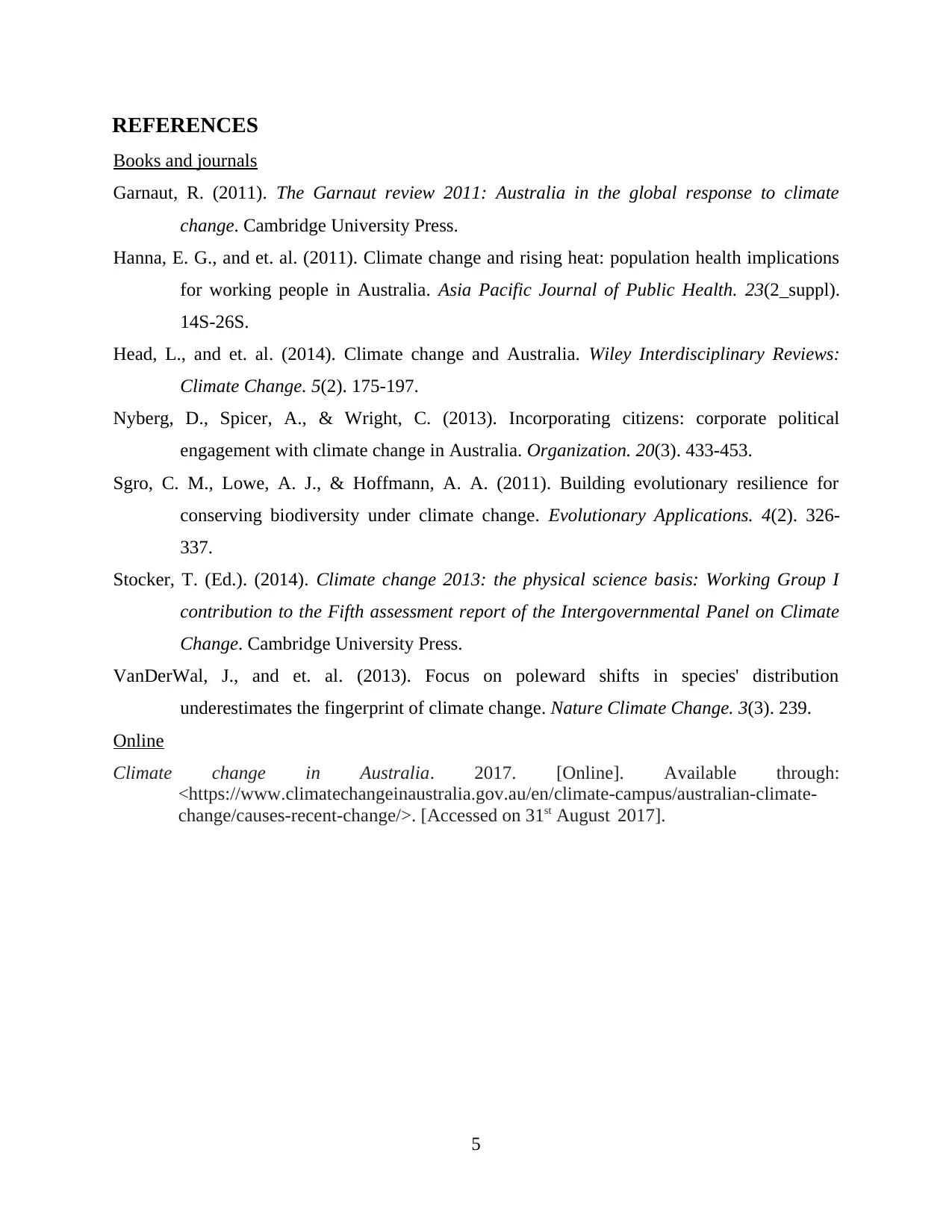
REFERENCES
Books and journals
Garnaut, R. (2011). The Garnaut review 2011: Australia in the global response to climate
change. Cambridge University Press.
Hanna, E. G., and et. al. (2011). Climate change and rising heat: population health implications
for working people in Australia. Asia Pacific Journal of Public Health. 23(2_suppl).
14S-26S.
Head, L., and et. al. (2014). Climate change and Australia. Wiley Interdisciplinary Reviews:
Climate Change. 5(2). 175-197.
Nyberg, D., Spicer, A., & Wright, C. (2013). Incorporating citizens: corporate political
engagement with climate change in Australia. Organization. 20(3). 433-453.
Sgro, C. M., Lowe, A. J., & Hoffmann, A. A. (2011). Building evolutionary resilience for
conserving biodiversity under climate change. Evolutionary Applications. 4(2). 326-
337.
Stocker, T. (Ed.). (2014). Climate change 2013: the physical science basis: Working Group I
contribution to the Fifth assessment report of the Intergovernmental Panel on Climate
Change. Cambridge University Press.
VanDerWal, J., and et. al. (2013). Focus on poleward shifts in species' distribution
underestimates the fingerprint of climate change. Nature Climate Change. 3(3). 239.
Online
Climate change in Australia. 2017. [Online]. Available through:
<https://www.climatechangeinaustralia.gov.au/en/climate-campus/australian-climate-
change/causes-recent-change/>. [Accessed on 31st August 2017].
5
Books and journals
Garnaut, R. (2011). The Garnaut review 2011: Australia in the global response to climate
change. Cambridge University Press.
Hanna, E. G., and et. al. (2011). Climate change and rising heat: population health implications
for working people in Australia. Asia Pacific Journal of Public Health. 23(2_suppl).
14S-26S.
Head, L., and et. al. (2014). Climate change and Australia. Wiley Interdisciplinary Reviews:
Climate Change. 5(2). 175-197.
Nyberg, D., Spicer, A., & Wright, C. (2013). Incorporating citizens: corporate political
engagement with climate change in Australia. Organization. 20(3). 433-453.
Sgro, C. M., Lowe, A. J., & Hoffmann, A. A. (2011). Building evolutionary resilience for
conserving biodiversity under climate change. Evolutionary Applications. 4(2). 326-
337.
Stocker, T. (Ed.). (2014). Climate change 2013: the physical science basis: Working Group I
contribution to the Fifth assessment report of the Intergovernmental Panel on Climate
Change. Cambridge University Press.
VanDerWal, J., and et. al. (2013). Focus on poleward shifts in species' distribution
underestimates the fingerprint of climate change. Nature Climate Change. 3(3). 239.
Online
Climate change in Australia. 2017. [Online]. Available through:
<https://www.climatechangeinaustralia.gov.au/en/climate-campus/australian-climate-
change/causes-recent-change/>. [Accessed on 31st August 2017].
5
1 out of 7
Related Documents
Your All-in-One AI-Powered Toolkit for Academic Success.
+13062052269
info@desklib.com
Available 24*7 on WhatsApp / Email
![[object Object]](/_next/static/media/star-bottom.7253800d.svg)
Unlock your academic potential
Copyright © 2020–2025 A2Z Services. All Rights Reserved. Developed and managed by ZUCOL.




